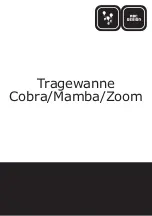
➃
Servo Tuning
29
Same as velocity feedforward control, this control action can improve the performance of linear
interpolation applications. In addition, it also reduces the time required to reach the
commanded velocity. However, if your application only requires short, point-to-point moves,
acceleration feedforward control is not necessary.
Acceleration feedforward control does not affect the servo system's stability, nor does it have
any effect at constant velocity or at steady state.
Tuning Setup Procedure
Use the following procedure to set up your servo system before completing the tuning
procedures. You can perform this procedure for both axes simultaneously.
Before you set up for tuning:
Do not begin this procedure unless you are sure you have successfully completed the
following system connection, test, and configuration procedures provided in Chapter 3:
❏
Connect the motor drive (especially the shutdown output)
❏
Connect and test the encoders
❏
Connect and test the end-of-travel limits
❏
Test the 6250's
±
10V analog output
❏
Couple the motor to the load, and couple the encoder to the motor (or load)
❏
Configure the number of axes in use, drive fault level, and encoder resolution
(these can also be configured in Motion Architect)
E M E R G E N C Y S H U T D O W N
If you need to shutdown the motor drive during the tuning process (for instance, if the
system becomes unstable or experiences a runaway), issue the
DRIVEØØ
command. If your
motor drive does not have a shutdown input, use a manual emergency stop switch to
shutdown the drive's power supply. You can also use the
E N B L
input to disable the 6250's
analog output signal.
S t e p 1
Make sure the power to the motor drive is off.
S t e p 2
Apply power to the 6250 only and issue the
DRIVE11
command. Measure the 6250's analog
output between the
C M D +
and
C M D -
terminals on the
D R I V E
connector with both an
oscilloscope to check for noise and a digital volt-meter (DVM) to monitor the analog output.
Both readings should be very close to zero volts. If an offset exists, ignore it for now; it will
be taken care of later.
N O T E
Use an isolation (
cheater) plug to isolate the
oscilloscope from the power source ground; do
the same to the DVM if it also uses the same
power source. The isolation plug minimizes the
system's noise level and eliminates ground loops.
Oscilloscope or DVM
Isolation Plug
S t e p 3
If your system has mechanical stops, manually move the load to a position mid-way between
them.
S t e p 4
Enter these commands to zero all the gains and run the system in open loop:
Co mma n d
De s c r i p t i o n
>
SGPØ,Ø
Set the proportional feedback gain to zero
>
SGVØ,Ø
Set the velocity feedback gain to zero
>
SGIØ,Ø
Set the integral feedback gain to zero
>
SGVFØ,Ø
Set the velocity feedforward gain to zero
>
SGAFØ,Ø
Set the acceleration feedforward gain to zero
S t e p 5
Apply power to the motor drive. The motor shaft should be stationary or perhaps turning very
slowly (velocity drive). A small voltage to a torque drive, with little or no load attached, will
cause it to accelerate to its maximum velocity. Since the torque demand at such a low voltage
is very small, you can prevent the shaft from moving by holding it.
















































